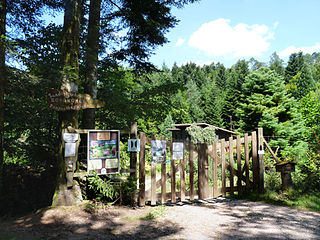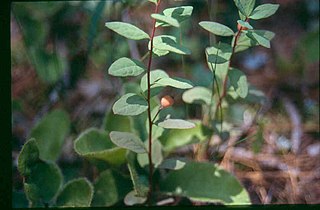
The Ericales are a large and diverse order of dicotyledons. Species in this order have considerable commercial importance including for tea, persimmon, blueberry, kiwifruit, Brazil nuts, argan, and azalea. The order includes trees, bushes, lianas, and herbaceous plants. Together with ordinary autophytic plants, the Ericales include chlorophyll-deficient mycoheterotrophic plants and carnivorous plants.

The Ericaceae are a family of flowering plants, commonly known as the heath or heather family, found most commonly in acidic and infertile growing conditions. The family is large, with about 4,250 known species spread across 124 genera, making it the 14th most species-rich family of flowering plants. The many well known and economically important members of the Ericaceae include the cranberry, blueberry, huckleberry, rhododendron, and various common heaths and heathers.

A shrub or bush is a small-to-medium-sized perennial woody plant. Unlike herbaceous plants, shrubs have persistent woody stems above the ground. Shrubs can be either deciduous or evergreen. They are distinguished from trees by their multiple stems and shorter height, less than 6–10 m (20–33 ft) tall. Small shrubs, less than 2 m (6.6 ft) tall are sometimes termed as subshrubs. Many botanical groups have species that are shrubs, and others that are trees and herbaceous plants instead.

Ukkusiksalik National Park is a national park in Nunavut, Canada. It covers 20,885 km2 (8,064 sq mi) of tundra and coastal mudflats south of the Arctic Circle and the hamlet of Naujaat, from Hudson Bay's Roes Welcome Sound towards the western Barrenlands and the source of Brown River. The park surrounds Wager Bay, a 100 km (62 mi)-long inlet on the Hudson Bay. Although the smallest of Nunavut's four national parks, it is the sixth largest in Canada. Its name relates to steatite found there: Ukkusiksalik means "where there is material for the stone pot".

Mer Bleue Bog is a 33.43 km2 (12.91 sq mi) protected area in Gloucester, Ontario, an eastern suburb of Ottawa in Eastern Ontario, Canada. Its main feature is a sphagnum bog that is situated in an ancient channel of the Ottawa River and is a remarkable boreal-like ecosystem normally not found this far south. Stunted black spruce, tamarack, bog rosemary, blueberry, and cottongrass are some of the unusual species that have adapted to the acidic waters of the bog.
A calcifuge is a plant that does not tolerate alkaline (basic) soil. The word is derived from the Latin 'to flee from chalk'. These plants are also described as ericaceous, as the prototypical calcifuge is the genus Erica (heaths). It is not the presence of carbonate or hydroxide ions per se that these plants cannot tolerate, but the fact that under alkaline conditions, iron becomes less soluble. Consequently, calcifuges grown on alkaline soils often develop the symptoms of iron deficiency, i.e. interveinal chlorosis of new growth. There are many horticultural plants which are calcifuges, most of which require an 'ericaceous' compost with a low pH, composed principally of Sphagnum moss peat. Alternatively sulphur chips may be used to lower soil pH.

The Northern California coastal forests are a temperate coniferous forests ecoregion of coastal Northern California and southwestern Oregon.

The Atlantic coastal pine barrens is a now rare temperate coniferous forest ecoregion of the Northeast United States distinguished by unique species and topographical features, generally nutrient-poor, often acidic soils and a pine tree distribution once controlled by frequent fires.

The New England-Acadian forests are a temperate broadleaf and mixed forest ecoregion in North America that includes a variety of habitats on the hills, mountains and plateaus of New England and New York State in the Northeastern United States, and Quebec and the Maritime Provinces of Eastern Canada.

The International Tundra Experiment (ITEX) is a long-term international collaboration of researchers examining the responses of arctic and alpine plants and ecosystems to climate change. Researchers measure plant responses to standardized, small-scale passive warming, snow manipulations, and nutrient additions. Researchers use small open-top chambers (OTCs) to passively increase mean air temperature by 1-2 °C. The ITEX approach has been validated by tundra responses at the plot level. The network has published meta-analyses on plant phenology, growth, and reproduction, composition and abundance, and carbon flux. The ITEX network consists of more than 50 sites in polar and alpine locations around the world.
The biogeoclimatic zones of British Columbia are units of a classification system used by the British Columbia Ministry of Forests for the Canadian province's fourteen different broad, climatic ecosystems. The classification system, termed Biogeoclimatic Ecosystem Classification, exists independently of other ecoregion systems, one created by the World Wildlife Fund and the other in use by Environment Canada, which is based on one created by the Commission for Environmental Cooperation (CEC) and also in use by the US Environmental Protection Agency (EPA). The system of biogeoclimatic ecosystem classification was partly created for the purpose of managing forestry resources, but is also in use by the British Columbia Ministry of Environment and Climate Change Strategy and other provincial agencies. A biogeoclimatic zone is defined as "a geographic area having similar patterns of energy flow, vegetation and soils as a result of a broadly homogenous macroclimate."

The Jardin botanique de Gondremer is a private botanical garden with national collections of rhododendrons and azaleas, kalmia, heathers, and Japanese maples, classified as a Jardin Remarquable by the French ministry of culture. It is located several kilometers east of Autrey and Housseras, Vosges, Grand Est, France, and open at specific periods suitable for the collections; an admission fee is charged.
An oak–heath forest is a plant community association and type of forest ecology. It is a deciduous forest type of well-drained, acidic soils, characterized by oaks (Quercus) and plants of the heath family (Ericaceae). It is commonly found in the high elevations of the eastern United States. Such forest areas typically have a dense fibrous root layer at the surface of the soil, and in many areas predominate on south-facing or southwest-facing slopes. Many of the existing oak–heath forests once featured American chestnut as an important canopy species.

Geocaulon is a monotypic genus of flowering plants in the family Santalaceae containing the single species Geocaulon lividum, which is known by the common names northern comandra and false toadflax. It is native to northern North America, where it is common and widespread from Alaska to Newfoundland and into the northernmost contiguous United States.

Carex bigelowii is a species of sedge known by the common names Bigelow's sedge, Gwanmo sedge, and stiff sedge. It has an Arctic–alpine distribution in Eurasia and North America, and grows up to 50 centimetres (20 in) tall in a variety of habitats.